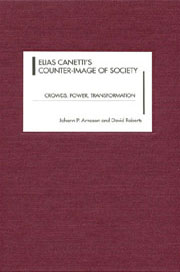Introduction
Published online by Cambridge University Press: 05 February 2013
Summary
Despite the publicity associated with the awarding of the Nobel Prize for literature in 1981, Elias Canetti remains an outsider, whose significance as a seminal cultural-diagnostic thinker of our century has not been adequately recognized. His distinctive anti-systematic form of theorizing, which cuts across the customary boundaries between genres and between imagination and theory, confronts the interpreter with particular difficulties. If his place in literary history seems assured, due above all to his one novel Die Blendung (written 1930–31, published 1935, English translation Auto da Fé, 1947) and his three volumes of autobiography, his place in the history of social and political thought is still undetermined. The distinctive theoretical contribution of Masse und Macht (1960, English translation Crowds and Power, 1962) presents a challenge that has scarcely been tackled.
Behind the lengthy gestation of Crowds and Power lies the deciding experience of the crowd for Canetti in Frankfurt in 1922 (the murder of Rathenau) and in Vienna in 1927 (the burning of the Palace of Justice). His life's work revolves around the task of exploring the significance of the crowd in history against the background and challenge of the crisis of European culture and society and the mass politics of totalitarianism, the central phenomenon of the twentieth century and the test case for all social theory. It is this crisis that he has in mind when he speaks of seizing the century by the throat. His metaphor can, however, also be understood as aiming at the century where it is most vulnerable: in its blind assumptions of progress.
- Type
- Chapter
- Information
- Elias Canetti's Counter-Image of SocietyCrowds, Power, Transformation, pp. 1 - 4Publisher: Boydell & BrewerPrint publication year: 2004



